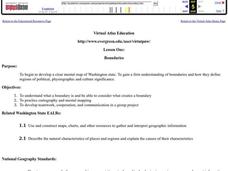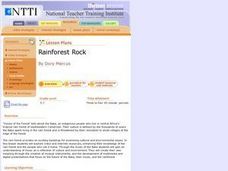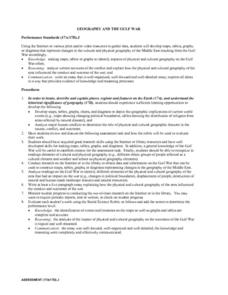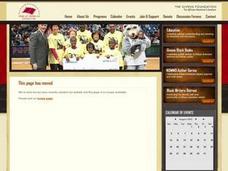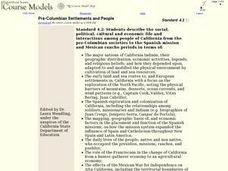Curated OER
United States & Canada: How Are We The Same? How Are We Different?
Pupils compare and contrast similarities and differences between Canada and the US. In this geography lesson, students read various articles and identify similarities and differences in economies, cultures, geography, climate, and...
Curated OER
Geography/Current Events Project
Using the Balkan region as an example, fourth graders review the five themes of geography as a class. They identify the physical and human characteristics of a region before labeling the countries and landforms on a map. They then...
Curated OER
Boundaries
Students are introduced to the term of mental mapping. Individually, they develop their own mental map of Washington state and discuss as a class what makes a boundary. They draw their mental map on paper and compare it with their...
Curated OER
Afghan I Stand
Students explore the history of ethnic groups, leadership, internal and external conflicts, social and economic conditions, and geographical boundaries of Afghanistan to present to fellow classmates at a teach-in.
Curated OER
Rainforest Rock
Students discuss the impact of environmental change on people and culture; create musical instruments that reflect cultural influences. apply musical concepts, evaluate Internet resources, and make a meaningful presentation.
Curated OER
An Introduction to Shamanism
Students investigate Inuit customs. In this cultural traditions lesson, students read about religious customs of the Inuit including Shamanism. Students discuss the role of Shaman and create Inuktitut-English dictionaries with terms...
Curated OER
Cultural Maps
Fifth graders examine map elements. In small groups they create a map of an imaginary country that includes a title, legend, directional indicator, scale, boundaries, capital cities, country name, and icons of five natural resources. ...
Curated OER
Crossroads: Chicano Identity and Border Culture
Learners identify and explore complex ways that the theme of "frontiers" or socio-political borders affect Chicano identity in the US and examine notions of "resistance" and "affirmation" as a fundamental ideology in Chicano life,...
Curated OER
Ideas and Commodities Cross Cultural Regions
Students compare and contrast how commodities native to certain countries have impacted the economies of other nations. After gathering information regarding how commodities are grown and traded, students use their information to...
Curated OER
The Cherokee: Trail Where They Cried
Students read the Trail of Tears about the Cherokee Nation removal and write a letter pretending they are the grandparent of a Cherokee child. In this Trail of Tears lesson plan, students understand the changing of boundaries.
Curated OER
Geography And The Gulf War
Young scholars develop maps, tables, graphs, charts, and diagrams to depict the geographic implications of current world events, and analyze major human conflicts to determine the role of physical and cultural geographic features in the...
Curated OER
Investigating Stereotypes
Students study 'stereotype' in literature and life and give examples. they provide examples from life or literature on the origins and impact of stereotypes. they
3. Cite 3 - 5 individual African Americans from literature or life who...
Curated OER
Mapping School Grounds
Learners map and analyze the natural and cultural environment of the school grounds. In small groups, they sketch the natural and cultural features of each side of the school building, create a map, participate in a class discussion,...
Curated OER
Pre-Columbian Settlements and People
Fourth graders describe the social, political, cultural and economic life and interactions among the people of California from the pre-Columbian societies to the Spanish mission and Mexican rancho periods.
Curated OER
The Blackfeet of Glacier National Park
Learners research an aspect of the Blackfeet tribe in Glacier National Park. They work together to create a presentation that is representative of their culture. They share their presentation with the class.
Curated OER
Of Amulets And Scrolls
Students come to an understanding of the time period covered in the first five books of the Bible by researching and recreating ancient artifacts. They recreate artifacts that represent the people, lifestyles, and culture of people...
Curated OER
Oh Canada!!
Fifth graders become familiar with the people, culture, government and geography of Canada. In this Canadian people and places lesson plan, 5th graders research and create a map of Canada reflecting their gathered information. ...
Curated OER
You're In My Space!
Students explain how political, social, and economic boundaries can be changed through cooperation and conflict. Small groups are assigned a particular trouble area of the world. Each group studies a particular side of the conflict.
Curated OER
Paper Weaving
Practice the native concept of weaving with traditional classroom items. Using assorted colors of construction paper, your class will simulate how to weave. This is a great activity to connect to a Native American, Mexican, or other...
Curated OER
Jazz in America Lesson Plan 6
Students survey bebop, cool jazz, and hard bop. They explore how bebop, cool jazz, and hard bop reflected American culture and society in the 1940s and 1950s.
Curated OER
What Masks Reveal
Students explore the cultural significance of masks by investigating the role they play in ceremonies and on special occasions in societies from widely separated regions of the world.
Curated OER
What is Southeast Asia?
Learners participate in various classroom activities designed to teach them about the location and cultures of countries in Southeast Asia.
Curated OER
Is A Nation Always A Region?
Students define the term, "nation," and analyze the boundaries established in Africa by colonial powers. In small groups, they participate in a simulated United Nations, develop a list of questions, analyze the nations of Africa, and...
Curated OER
Independence Masks
Young scholars explore how art reflects the economic, political, social, religious and historical concerns of a culture. They research a former colony to determine if there is any history of a mask. Students create a mask representing...




